
By Ruth Gooch
Little known, even by those mainlanders who live closest to it, French Island is the largest of the Western Port islands comprising some 16,350 hectares. Surrounded by mud flats at ebb tide, it appears remote, mysterious even. There are vague tales of buried treasure, long-ago escaped convicts from Tasmania, and an island ‘spook’ which has been pursued at full gallop on horseback. One old map has the name ‘Bushranger Point’ marked on the south coast, but how the name originated, of course, is not now known.
The island is ‘unincorporated territory’, meaning it does not form part of any municipality, its inhabitants do not pay rates, and the island is administered directly by the Victorian Government’s Ministry of Transport, Planning and Local Infrastructure, in consultation with an island committee. The population has never consisted of more than a few hundred, the comparative isolation and difficult terrain defeating most of those who attempted to settle there. However, a handful of families did succeed and descendants of 1890s settlers are among the current resident population of about 100 people.
Cricket
This has always been the main game, although it has had a chequered history. The first club was formed about 1898 with selector George Harrop as captain, and another selector, Rowland Peck as president. Peck loaned a piece of his land so that the club could have a ground to play mainland teams, although early matches were amateurish. The Westernport Times reported a game between the island and Bass played at the Corinella ground on 22 December 1899, although most of the ‘French Island’ team came from either Corinella or Bass, because the island did not have enough men to make up the numbers. The game bordered on a debacle with ‘French Island’ scoring 24 runs and Bass 31. The top score was 8. The lack of runs was explained by the ‘exceptional roughness of the pitch’.
The island wag, Fred Bond, who was working at Corinella in 1899, had earlier written a poem and sent it back to the island in order to try and inspire island men. After some verses of admonition, he continued:
So stick on your hats and pick up your bats
On the ground that was lent you by Peck
And if money is short and tools must be bought
Just ask some kind gent for a cheque
So clap on your pads and at it my lads,
To say you’re not able is ‘rich’,
Not heeding the bumps just stand to the stumps,
And slog the old ball round the pitch…
Apparently the cricket lapsed, for in 1909, Fred was recording that he and islander Frank Broderick were ‘always getting up some new craze in amusements. At one time it was bezique [a card game for two, played with a double pack of 64 cards], then high jumping, now it is draughts, they are fair dotty on draughts’.
An impetus was given to cricket when a Mornington businessman who had an allotment at Fairhaven on the island’s west coast donated a piece of his ground to be used as a recreation ground. It and an adjacent hall were officially opened in October 1914 and after a speech by the President of the Fairhaven Progress Association, the Union Jack was raised by Mrs De La Haye Senior and Mrs Cheeseman. The Fairhaven flag (design now unknown) was then raised by Mrs Rue De La Haye and Mrs E. Bennetts.

Not to be outdone, the rival French Island Progress Association called a working bee for October 4 in order to create a recreation ground in a corner of Bennetts’ allotment at Tankerton. About 20 workers came with mattocks, slashers, and Trewhalla jacks. Scrub was cleared by lighting a fire. The men did such a good job, said a newspaper report, that it was expected only one more day would be required to clear the entire ground. A concrete pitch was laid and a sports pavilion subsequently erected.
Island men’s cricketing ability skilled up and the Peninsula Post described a match in February 1915 against Grantville, the story beginning at the point where island men left home at 7 a.m. and caught the motor boat which left Stockyard Point at 8 a.m. After ‘a most pleasant bay trip’ the players landed at Tenby pier. From there, it was a two and a half mile walk to Grantville where they arrived at 11.15 a.m. Dinner was provided for them at the Grantville Hotel after which ‘the islanders felt in great form for cricket’. French Island proved to be the superior side, as Grantville, who batted first, were all out for 46 runs. Frank Broderick, bowling for French Island, was reported to be ‘unplayable at times’. French Island closed their innings for 74 with a loss of 5 wickets. Tea was provided at the hotel with much ‘barracking’, and the islanders left for the return trip at 7 p.m.
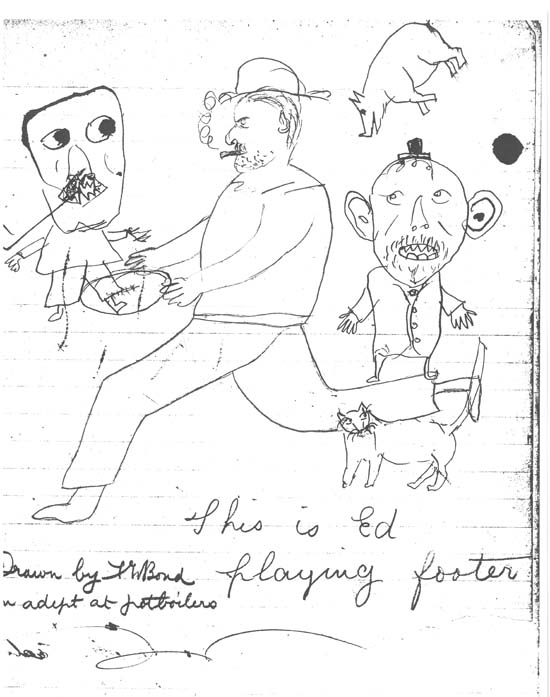
The First World War put a temporary end to cricket, for 30 French Island men enlisted, an extraordinary number for such a small community. But after the war, the island was fielding two teams which played teams from around the bay. The sports pavilion at the recreation ground at Tankerton was re-built in 1922 and the concrete pitch re-laid. The white-ant infested Mechanics Institute Hall in the centre of the island was partly demolished (the flooring was saved) and re-built at the Tankerton location in 1930. The entire complex was gazetted in 1933; among subsequent regulations, no person was to ‘enter or remain in the Reserve who may offend against decency in dress, language or conduct’. Nor was any person permitted to climb or jump over the gates or fences.
At some stage the concrete cricket pitch was abandoned so as to be in keeping with other grounds, but a commentator described the alternative pitch as ‘very rough’. And after a heavy rain, the ground would become sodden.
Fairhaven gradually faded away and is now only a campsite.
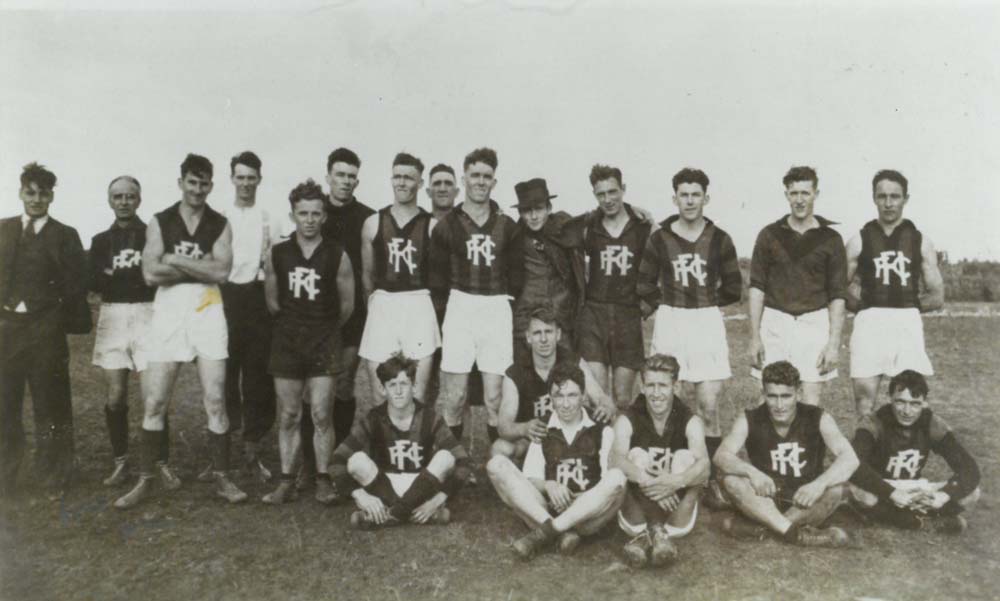
Football
The origins of the football club are unknown, but the island was fielding a team before the First World War. A ‘Leisure Hour’ held regularly at the Mechanics Institute Hall had Fred Bond writing a report in an exercise book after one such occasion and noting that Tim Whyatt and Jack Ratford had argued the point about a match which French Island had lost against Phillip Island the previous Saturday. Whyatt insisted that if Ratford had only passed the ball to him instead of being selfish with it and going for free kicks which the umpire did not allow, then in Bond’s words, ‘Tim could have turned round twice, dodged Barney Brown and four others, ran 72 yards 4 inches and kicked a whole six points and thereby saved the French Islanders from the demoralization of defeat’. According to Bond, Ratford ‘s response was to tell Whyatt that ‘the correct thing to do with his face was to fry and then boil it’.
As with the cricket team, the football team almost certainly disbanded due to the war. Fred Bond joined the army and as a corporal, was killed in action at Gallipoli.
External football matches probably did not resume until the 1938-40 season when the island played in the Phillip Island competition, a vacancy having been created by the withdrawal of the Cowes club which had difficulty in fielding 18 players. That left the Rhyll team at the east end of Phillip Island and Ventnor at the west end. But French Island too was always handicapped by insufficient players. Nor, due to farm commitments, were the customary players always available Even so, French Island won an occasional game.
If a football match was at ‘home’ there was the disadvantage of the poor ground at Tankerton which would not grow grass, and if the game was ‘away’, there was always the difficulty of transport. The cost of the big ferries was prohibitive, and because football is a winter sport, most fishermen had their boats out of the water (to say nothing of the fact that they were not licensed to carry passengers). Some islanders travelled in Jack Ratford’s boat, but the rest went with a Phillip Island boatman who was not experienced with the fact that cross-currents near Tortoise Head (off the south-west tip of French Island) can be quite dangerous and that had a near disastrous consequence.
One winter evening after a football match, the boatman left Cowes with about 28 French Islanders aboard. It was almost dark and the boat set off ‘in the teeth’ of a howling north wind and an ebb tide. ‘The motor was slow and so was the progress’. As they approached the Tortoise Head buoy at the south-west corner of French Island, water came over the stern of the boat and put out the motor. At the same time, some of the passengers looked back and saw a wave about nine metres high pass close to the stern of the boat, only narrowly missing it. But luckily, on the first turn of the engine, the boatman succeeded in getting it going, and despite a very rough sea, the islanders were safely landed at Tankerton where ‘the jetty felt good’. Jack Ratford had passengers in his boat also, but he moored safely at his own berth on the south coast and did not have to negotiate the ‘horror stretch’ near Tortoise Head.
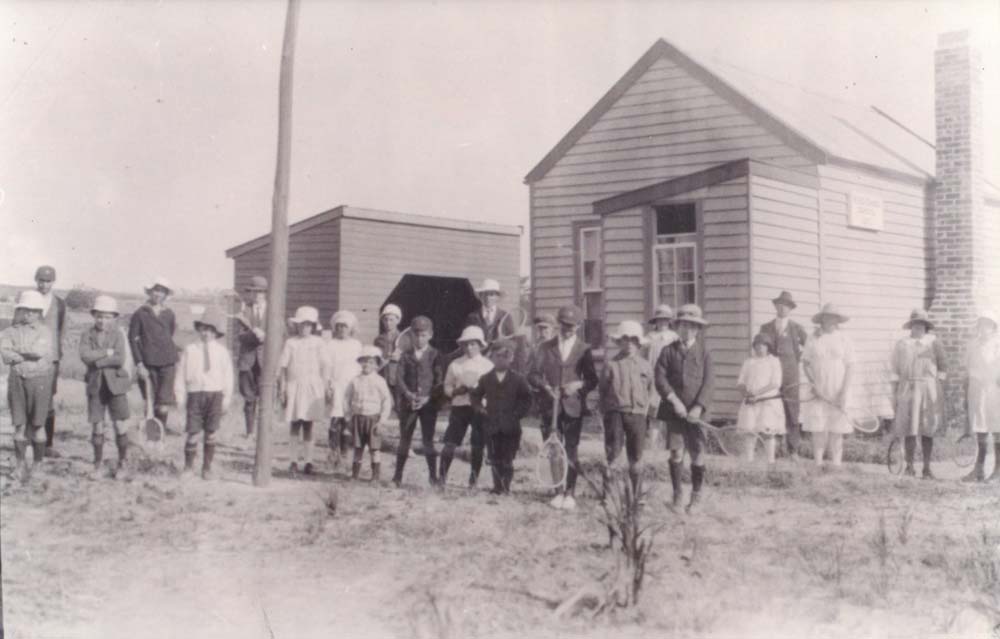
After the Phillip Island boatman had delivered his passengers at Tankerton that night, he put up his sail and headed back to Rhyll, his home port, but on arriving, he jibbed his sail, and the force of the wind took the mast out of the boat, and he had to swim into the Rhyll channel. After that, there were many less French Island football supporters. The competition lasted for about three years, the shortage of men during World War 2 bringing it to an end. Eighteen French Island men enlisted, again a significant number from a very small population.
In the latter 1940s, when the island no longer had a football team, islander Cecil Duscher who was a good player, joined the Hastings club on the Mornington Peninsula, one of his team mates being the legendary John Coleman who went on to become a star player with the city club, Essendon. Duscher was a great story teller and one of his yarns concerned the occasion when the team visited a country town and while walking down the main street, Coleman, with his legendary leap, jumped up, swung from a sign and broke it. The boys very quickly disappeared into nearby shops.
Tennis
School children in the early 1920s played on a tennis court marked out on the ground near the school, but by the latter 1920s, the island had a ‘fine asphalt tennis court’, laid by island volunteers. The ‘Garth Challenge Cup’ (presumably donated by Garth Bennetts, although using his first name seems a bit odd) was inaugurated in 1932, with Elsie Thomson (later, that well-known old island lady, Mrs Cox) winning the ladies event three times: 1936, 1938, and 1939. The event seems to have been discontinued after that date, again, presumably because of the war.
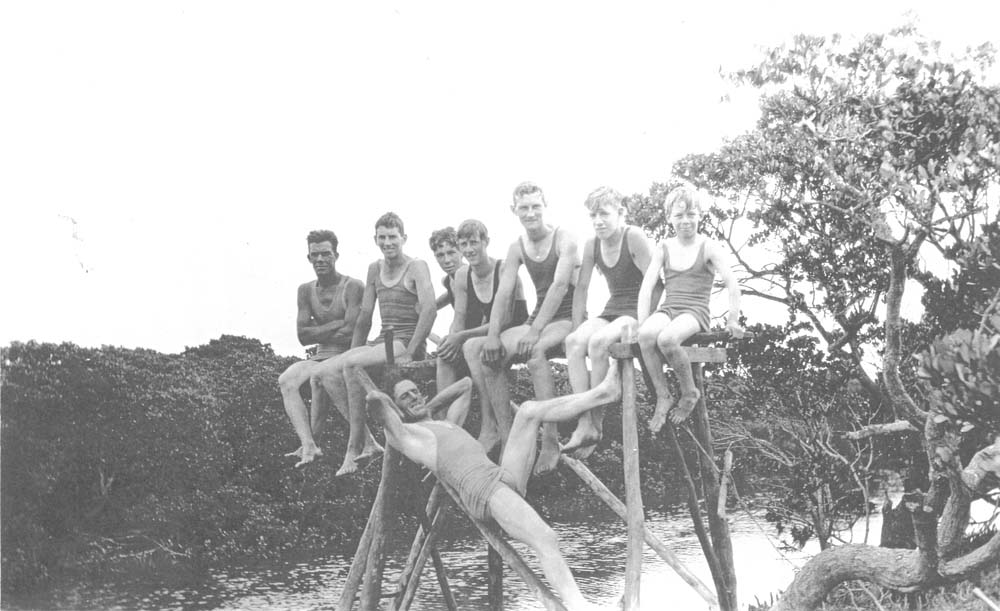
Annual Sports Meeting
The big event on the French Island calendar in the 1930s was the New Year’s Day sports at Tankerton, followed by a dance in the evening. The day before the event there was a ‘working bee’ to prepare the ground and peg it out for the races, the pegs consisting of tea tree sticks about a metre long. Little coloured flags were attached to the top of the sticks and it all looked ‘very exciting’ when the children and adults arrived next day. The sports were preceded by a lunch which both men and women had prepared the previous day: Mrs Josie Duscher would cook a large piece of silverside beef and that evening, the committeemen would arrive to cut the sandwiches. They sliced by hand 12 large loaves which were about half a metre long, minced the silverside, shredded cheese, and sliced Strasburg sausage to use as fillings for the buttered bread. As a prank, they always made a couple of ‘bodgie’ sandwiches made with a slice of brown paper and silverside. Island ladies made cakes and pastries which they brought in baskets, and additional fare was ordered and supplied by the Hastings bakery on the mainland. On the day, four-gallon kerosene tins with attached wire handles, were filled with water and boiled on an outside fire, and a big bag of tea was plunged in. If anyone complained that the tea was too weak, the bag was given an extra squeeze. Summer visitors to the island were able to attend free of charge, but when discreetly asked for donations, they were not remembered as ‘ever having loosened their purse strings to any great extent’.
After lunch, the sports began. William Duscher (Josie’s husband) with a handful of notes, would announce the races: ‘Children under Three’, he would call out, and so it went on, with separate races for boys and girls up to the age of about 16 years. That would be followed by a ‘young ladies race’, a ‘married ladies race’, sack races, and Siamese races for various ages. Siamese races were common to sports meetings everywhere and consisted of the right leg of one contender being tied to the left leg of the other participant, but running tied together was so difficult to accomplish that a pair of contestants usually fell and rarely made it to the finish line.
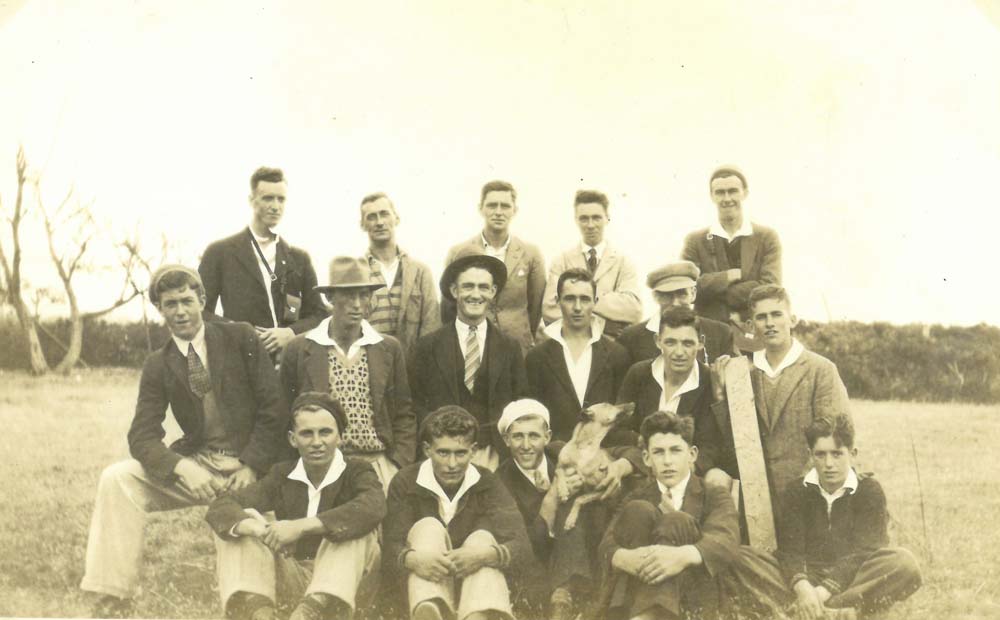
Then there was the women’s driving the nail competition where a competitor would get down on her knees and attempt to drive a big round headed nail into a red gum post. That always attracted spectators, and some newcomer ladies were so nervous that they would take an unfortunate swipe at the nail with a hammer and the nail ‘would fly off like a missile’. One particular lady usually won the competition attracting comment that she must have practiced at home.
With a very full programme, Duscher would push ahead with the men’s races: the 100 yards, 220 yards, 440 yards and the one mile race were all ‘watched keenly’. Most islanders, men and women, rode horses, so there were events like flag and barrel, and walk, trot and gallop. At the conclusion of the sports, there were some ‘fairly grubby kids’, who would get a freshen up with a face cloth, combed hair, and any extra clothes which ‘Mum’ had on hand. The new hall, opened in 1930 at Tankerton, had to be kept clean for the dance, so both lunch and tea were served outside under the gum trees, seating being provided by wooden forms which the young men would take out from the hall.
The Prison
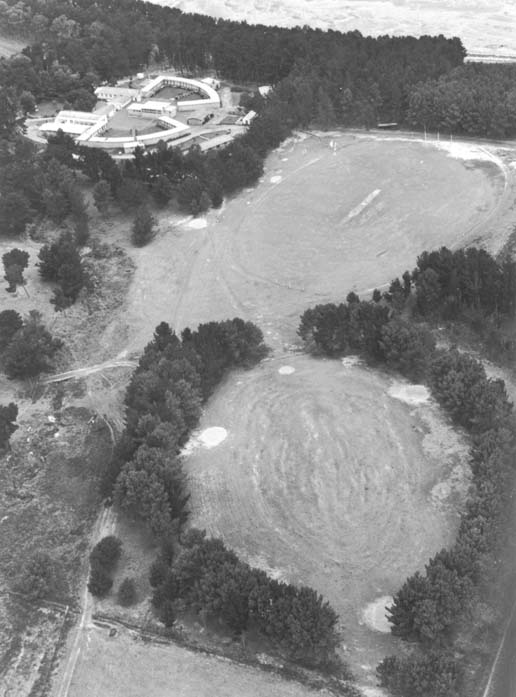
The Crimes Act of 1915 embodied the principle that outdoor life afforded the opportunity for character building, and prison rehabilitation farms were subsequently established at French Island and Castlemaine. An area for the French Island prison was selected on Brella Creek at the south-east, and duly proclaimed on 26 July 1916. It was developed as a farm and afforestation nursery, a government pine seedling nursery having already been established in 1913.
Initially, there were only a few prisoners housed in tents. Their requests were heard by members of the Indeterminate Sentences Board when they visited every two months. Permission was given in May 1917 for a sports meeting to be held to celebrate the King’s birthday, and for residents on the island to attend. A football ground was subsequently laid out at the prison and matches were held with islanders, but because there were more prisoners than islanders, teams were selected from both groups and ‘enjoyable matches held’. A cricket pitch was also laid down by the prisoners, and the Minutes of the Indeterminate Sentences Board note that on 11 January 1922, approval was given by the Board for 14 prisoners to contribute one shilling per head so as to entertain the French Island Cricket Club later that month. Permission was also given for the men to spend one shilling each on cricket balls (the money taken from the allowance allotted to the men by the Forests Department).
Alf McLean was transferred to the Forests Department on French Island in 1920, and he recalled that, “Through the winter months teams of footballers would come to the island to have a game against the prisoners. I used to play rover for the prison team; we were never beaten. Wonthaggi would come over [and] a good number of visitors, and what a supply of food etc. they would bring! No liquor as this was not allowed. It was always a great day when they came. On the days when the Church of England minister came, we would arrange swimming matches etc. for amusement. Among the prisoners the favourite prize was a one ounce plug of tobacco. Their tobacco issue was only thin plugs of ‘flap jack’, a very dark tobacco. They said it was from the sweepings of the factory, and it was certainly pretty rough for smoking, but had a pleasant odour. Any other better tobacco was a real treat for them”.
When Dr Appleford from Lang Lang paid his quarterly visit in December 1925, he brought a cricket team with him, and ‘victory rested with the camp’. The men were subsequently permitted to play mainland teams, and the annual report on Victorian prisons 1928, for example, noted that on the whole, French Island prisoners had worked willingly and well, and that, ‘They were given the privilege of playing five cricket and three football matches with visiting clubs from the mainland’. The annual report for 1930 noted: ‘Several football and cricket matches were played with visiting teams, and the Wireless allowed at appointed times was appreciated by the prisoners’
The thirteen members of the Bayles Cricket Club who visited in January 1931, were impressed with the well-laid-out flower gardens, well-kept lawns and vegetable gardens. The Bayles men took their own food for dinner, and in the afternoon, played the cricket match; predictably the prison team won. The prisoners, wrote the reporter with the Bayles team, ‘tell us that it is a red letter day when teams come over, and they talk about it for days afterwards’. After tea in the dining room, the Bayles men donated their left-over food and cakes to the prisoners, which ‘perhaps remind them of home and mother’. The evening ended with all of the men singing ‘For they are Jolly Good Fellows’, the reporter concluding that, ‘Wet through and tired, but very happy, it was the best day we had for a long time – the day with the King’s guests’.
The annual prison report for 1935, noted: ‘In their spare time they [the prisoners] play cricket and football, fish and swim, and generally lead the life of men in camps’. The same comment was made the following year with the additional remark that, ‘Matches are arranged with visiting teams and on these occasions, the conduct of the prisoners is exemplary’. The visits were all the more appreciated because the prisoners were not permitted visits by family or friends, a policy which had been implemented when the prison opened in 1916 and it continued for several decades.

Although not officially remarked on, islanders continued to play cricket and football at the prison in the 1930s, despite the fact that the prison had plenty of men to choose from and the island residents did not. One former islander also remembered that the vegetable and flower gardens at the prison were always in ‘top condition’ and that ‘it always seemed a rather pleasant place to be, that is, if one could put aside the whole reason of it. Mostly, the inmates used to be bubbling at the thought of the Islanders coming over. They’d always have plenty of jokes and when visitors came they were allowed to wear their own clothes, which made them feel good.’ One prisoner was said to sport a Scotch College cap. (‘Scotch College’, it was said, with a shake of the head). Island men would take a case of oranges for the prisoners at football matches – doubtless a change from the ‘home brew’ which the deprived devised ways of making: plums did not always find their way into a pudding. Pumpkin also had an alternative use. Island people always seemed to know these things, although how they knew is uncertain: the warders, perhaps, looking for a chat to relieve the tedium of isolation.
But island good-will towards prisoners gradually evaporated, for an increasing number of escapes made islanders feel they were at risk. A ‘posse’ of angry island men armed with shotguns, re-captured three escaped prisoners hiding in a haystack in July 1953. This escape ‘brought a renewed outburst from islanders who want the penal settlement removed’, according to a press report. At a subsequent meeting, one resident said that he had armed his 12 year-old son with a rifle to guard the farm when he was away. He had instructed his son to shoot any strangers who refused to stop after being called on at 50 yards.
Prison authorities apparently ignored island concerns, and facilities at the prison continued to improve. It was noted in 1961 that, ‘A second tennis court has been completed and outside teams have visited and played tennis, table tennis, basketball and football’. A nine hole golf course was opened in 1962 (‘undulating with natural hazards’) designed by a long-term prisoner. With tighter security, there were no escapes or attempted escapes that year, and the official report noted that the prisoners ‘appreciate the good living conditions and the general atmosphere of harmony and progress. They have a sports committee to organize sporting activities and a general committee which works hard for the general betterment of the prison’. The following year, as well as the team sports, ‘Athletics meetings were held at Christmas and Easter.’ Next year, there was a similar report and ‘competition was keen’. In 1965, football matches were played against teams from Sunbury, General Motors Holden, the Apprentice Butchers, and Saint Bedes. One of the mainland teams in 1966 came from as far away as Fish Creek in Gippsland. A former 1967 prisoner has recalled that football matches could be fierce games with the casualties being wheeled off in the ‘French Island Ambulance’ (a wheelbarrow) and that those with the most severe injuries were taken across to a mainland hospital.
A new large boat for transport proved a great asset in 1967. Family visits were inaugurated and prisoners were permitted to receive their visitors ‘on the lawns affronting the institution, weather permitting, or otherwise within the precincts of the Prisoners Mess’. Loosely translated, that meant ‘conjugals’ took place on the foreshore. Prisoners that year made and repaired toys for children in the Gippsland area, and in 1969 it was reported that toys were made, repaired, or repainted for the Blind Institute and the Children’s Hospital. But the press in the sixties ran feature articles glamourising the prison, one journalist describing it as a ‘Country Club’, or a ‘glorified motel’, and listing all of the sports available: tennis, golf, football, cricket, badminton, fishing, and swimming’, and ‘often on Fridays, TV sets are allowed to stay on after 10 p.m. so prisoners can watch a late movie’.
However, the prison was operating at less than half capacity by the 1970s and morale had deteriorated. A decision was made to close, one of the official reasons being that, ‘The participation by prisoners in sporting, recreational, educational and hobby interests is not much in evidence and is minimized by the difficulties of isolation and access…’ The prison duly closed on 30 April 1975.

Island Sport to the Present Day
In the 1960s, French Island men were playing cricket in a Mornington Peninsula association, the entire team made up from the Thompson family whose members were then half of the island population. There was also a football team which had only seven island members – the rest of the team consisted of mainland relatives and friends; they played seven or eight social games each season. ‘Our players are old men and kids’, laughed a rotund Jack Norgate at the time. ‘We train each Wednesday and have a niner after each game. If we win it’s an excuse for a pie night and another grog up’. The rifle range was on Norgate’s property, and cattle were driven off prior to a shoot. Notices were posted on the ramp road behind the rifle butts, and at the entrance to the range before the bullets started flying.
Island sport these times is played on an irregular basis as numbers and enthusiasm permit. In the 1980-1990s, there was a darts and pool team that travelled to Corinella to play in pub competitions. Cricket has always been popular and until 2012, there were two cricket teams, although about half of the players were friends and relatives who went over to play for the island. Now, I am told, they are down to one team and struggling to keep that going. A new tennis court was built in 2006 with funds from the French Island Community Association and a grant from the Victorian Government Department of Sport and Recreation. The annual New Year Sports meeting, however, continues to be held.
© Ruth Gooch 2018
Ruth Gooch has published a number of books and peer-reviewed papers. A list of her publications is on her website www.ruth-gooch.com. Her books, Frontier French Island, and her history of Cape Schanck, The Wildest Bit along the Coast can be purchased at the Hastings newsagency and Petersen’s Bookshop.
The author acknowledges, with gratitude, the use of manuscript material provided by the Hyett family. Personal communications, the late Merl Le Barry. Personal communication, George and Colleen Robinson. Personal communication, Terry C.
Official Sources:
Australian Archives, Series B 24 55/1. Annual reports on Victorian Penal Establishments. The name of the Department responsible was changed a number of times over the years. Victorian Department of Justice files. Victorian Government Gazettes. Newspapers and Periodicals: Frankston and Somerville Standard. Herald (Melbourne). Hesperus. Koo-wee-rup Sun. Neptune News. Peninsula Post. Powlett Express. Victorian Foresters Newsletter. Wonthaggi Express.
Book: Joshua Gliddon (comp.) Phillip Island in Picture and Story, Cowes, 1958.
Dianne Spark
 The cricket photographs have been supplied by French Island resident Dianne Spark. She has been the scorer for French Island cricket team for 53 years and in 2000 received the Australian Sports Medal in recognition of her contribution. Dianne succeeded her father, Robert, one of the Thompsons in the c.1958 team and who was a member of the M.P.C.A. country week team for approximately 15 years. He was later manager of that side. The medal for best player in the Sub-District 1sts in the M.P.C.A. is named after Robert Thompson.
The cricket photographs have been supplied by French Island resident Dianne Spark. She has been the scorer for French Island cricket team for 53 years and in 2000 received the Australian Sports Medal in recognition of her contribution. Dianne succeeded her father, Robert, one of the Thompsons in the c.1958 team and who was a member of the M.P.C.A. country week team for approximately 15 years. He was later manager of that side. The medal for best player in the Sub-District 1sts in the M.P.C.A. is named after Robert Thompson.
Cec. Duscher
French Island has produced more than its share of characters; one of them was Cecil Duscher. Born in 1918, Cec. was one of five children of William and Josie Duscher, both of whom featured prominently in the early years of the New Years Day sports meeting.
Cec. played football for French Island in the 1930’s and can be seen in the photograph with one of his brothers. He must have decided, at the age of 29, that his football career was unfulfilled for in 1947 he ventured across to the mainland and played two games with Hastings. This was during the Coleman era (1946-1948) and so Cec’s frequently made claim to have been a team mate of John Coleman was valid, if only just. After a two year spell (1948 and 1949) Cec. resumed playing with Hastings, finally retiring in 1954. All told he played 40 games with Hastings, 16 of them in 1951.
On the Island Cec. worked on the family property and for a time this included the collection and baling of sea grass. In the 1950’s he provided the French Island taxi service; this consisted of a well worn panel van which, passengers were informed, served as a hearse, mail van, grocery delivery van, and wedding car.
Cec. was a greatly loved character both on the mainland and French Island. He particularly enjoyed catching up with his old teammates from his football days in Hastings, although in his latter years he suffered from narcolepsy. This would cause him to drop off to sleep in the middle of a conversation, a practice which only increased the number of Cec. Duscher stories.





